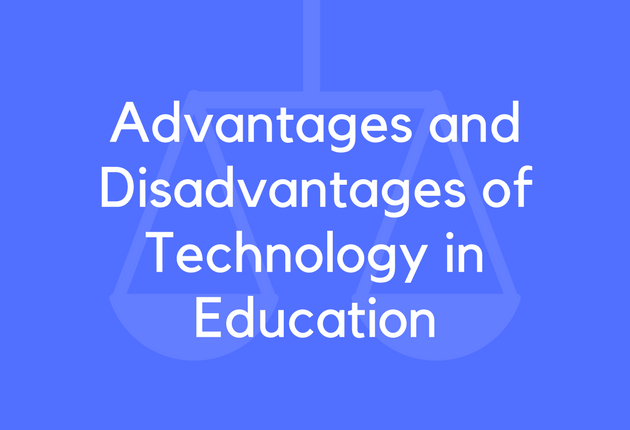The Impact of Technology on Education: Pros and Cons

Technology has transformed the way we live, work, and learn. In education, technology has become an integral part of the teaching and learning process, with many schools and universities incorporating digital tools and resources into their curricula. This article will explore the pros and cons of technology in education, and the importance of balancing the benefits with the potential drawbacks.
Elevate Your Writing with Our Free Writing Tools!
Did you know that we provide a free essay and speech generator, plagiarism checker, summarizer, paraphraser, and other writing tools for free?
Access Free Writing Tools
Technology has become an increasingly important part of education in recent years, with tools like online learning platforms, educational apps, and software transforming the way students learn and teachers teach. While technology offers many benefits, there are also some drawbacks and challenges that must be addressed.
One of the main advantages of technology in education is the increased access to information. With the internet and other digital tools, students have access to a vast array of resources and materials that can help them learn and explore new ideas. Technology can also enhance student engagement and motivation, providing opportunities for interactive learning and personalized instruction. For example, QR code generation can be used to create interactive learning experiences, where students can scan a code to access additional information or resources related to a topic.
Infographics are another powerful tool that can help students visualize and understand complex information. By presenting data and concepts in a clear and visually appealing way, infographics can make learning more engaging and effective. They can also help students develop critical thinking and analytical skills, as they learn to interpret and analyze visual data.
However, there are also some potential downsides to using technology in education. Digital distractions can be a major issue, with students spending more time browsing the internet or using social media than focusing on their studies. There is also the risk of over-reliance on technology, with students becoming too reliant on digital tools and losing important critical thinking and problem-solving skills.
In addition, there are concerns around access to technology, with students from lower-income families or underrepresented minority groups facing additional barriers to accessing digital resources. There are also security and privacy concerns, as schools and educators must take steps to protect students’ personal data and ensure that students are not exposed to inappropriate content or potential cyber threats.
To address these issues, educators and schools must take a thoughtful approach to integrating technology into their classrooms. They must be mindful of the potential benefits and drawbacks of technology and work to find ways to mitigate any negative impacts. This may involve developing policies and protocols for managing data privacy and security, providing training and support for students on safe and responsible online behavior, and working to ensure that all students have equal access to technology resources.
Overall, technology has the potential to be a powerful tool for improving education and enhancing learning outcomes. By taking a balanced and thoughtful approach to its use, educators and schools can help ensure that all students have the opportunity to benefit from the advantages that technology, including QR code generation and infographics, can offer.
The Pros of Technology in Education
1. Increased access to information
The internet has made a wealth of information available to students and educators at their fingertips. With online databases, digital textbooks, and educational websites, students can access a wide range of resources and information to enhance their learning. Additionally, online learning platforms like Coursera, Udemy, and Khan Academy provide access to high-quality courses and lectures from top institutions and experts around the world.
2. Enhanced student engagement and motivation
Technology can make learning more interactive and engaging. For example, gamification and educational apps can help students stay motivated and interested in the material. Virtual reality simulations can provide immersive experiences that bring learning to life, while educational games can make learning fun and engaging for students of all ages.
3. Customizable learning experiences
Digital tools and resources can be tailored to individual student needs and learning styles, allowing for more personalized learning experiences. Adaptive learning platforms like DreamBox and Knewton use data analytics and machine learning algorithms to adjust the pace and level of instruction based on individual student progress and performance.
4. Improved communication and collaboration
Technology allows for easier communication and collaboration between teachers and students, as well as among students themselves. Online forums, messaging apps, and video conferencing tools make it easier for students to ask questions, share ideas, and collaborate on projects. Platforms like Google Classroom and Microsoft Teams provide centralized hubs for class materials, assignments, and discussions, allowing for more streamlined communication and collaboration.
5. Integration of multimedia and interactive tools
Multimedia and interactive tools, such as videos, simulations, and virtual reality, can help students better understand complex concepts and engage with the material in a more meaningful way. For example, students studying biology can use virtual dissection tools to explore the inner workings of the human body, while students studying history can use interactive timelines and maps to visualize key events and concepts.
Everything you need to know about ChatGPT and GPT-4.
The Cons of Technology in Education
1. Digital distractions and the potential for decreased attention spans
With the vast array of digital distractions available, students may find it difficult to focus on their studies. Additionally, the constant stimulation of digital media may lead to decreased attention spans and difficulty concentrating. To mitigate these effects, educators can encourage students to take breaks from digital devices and engage in other activities that promote focus and concentration, such as meditation, exercise, or reading.
2. Overreliance on technology
Overreliance on technology may lead to a lack of critical thinking skills and the ability to solve problems without the aid of digital tools. To promote critical thinking and problem-solving skills, educators can incorporate activities and assignments that require students to think beyond the limits of digital tools, such as group discussions, debates, and hands-on projects.
3. Inequities in access to technology
While technology has the potential to level the playing field for students of all backgrounds, it can also exacerbate existing inequalities. Students who lack access to computers, high-speed internet, or other digital tools may struggle to keep up with their peers who have these resources readily available. In addition, students from low-income families or underrepresented minority groups may face additional barriers to accessing technology and may be less likely to pursue careers in technology-related fields as a result.
To address these issues, educators and schools can take a number of steps to ensure that all students have equal access to technology. For example, schools can provide loaner devices or allow students to check out laptops or tablets for use at home. They can also provide free or subsidized internet access to students who lack it. Additionally, educators can work to identify and address the specific needs of underrepresented students and provide targeted support to help them succeed.
4. Security and privacy concerns
The use of technology in education raises important security and privacy concerns. Schools and educators must take steps to protect students’ personal data, such as their names, addresses, and grades, as well as sensitive information like their social security numbers and medical records. They must also ensure that students are not exposed to inappropriate content or potential cyber threats.
To address these issues, schools and educators can implement a range of security measures, such as firewalls, antivirus software, and data encryption. They can also provide training to students on safe and responsible online behavior and encourage them to report any suspicious or concerning activity. In addition, schools can work with parents and other stakeholders to develop policies and protocols for managing data privacy and security, and to ensure that students’ rights are protected. By taking these steps, schools can help ensure that technology is used in a safe and responsible manner that benefits all students.
Technology has become an increasingly important part of education in recent years. From online learning platforms to educational apps and software, technology is transforming the way students learn and teachers teach. While there are many potential benefits to using technology in education, there are also some drawbacks and challenges that must be addressed.
One of the main advantages of technology in education is the increased access to information. With the internet and other digital tools, students have access to a vast array of resources and materials that can help them learn and explore new ideas. Technology can also enhance student engagement and motivation, providing opportunities for interactive learning and personalized instruction.
However, there are also some potential downsides to using technology in education. For example, digital distractions can be a major issue, with students spending more time browsing the internet or using social media than focusing on their studies. There is also the risk of over-reliance on technology, with students becoming too reliant on digital tools and losing important critical thinking and problem-solving skills.
In addition, there are also concerns around access to technology, with students from lower-income families or underrepresented minority groups facing additional barriers to accessing digital resources. There are also security and privacy concerns, as schools and educators must take steps to protect students’ personal data and ensure that students are not exposed to inappropriate content or potential cyber threats.
To address these issues, educators and schools must take a thoughtful approach to integrating technology into their classrooms. They must be mindful of the potential benefits and drawbacks of technology, and work to find ways to mitigate any negative impacts. This may involve developing policies and protocols for managing data privacy and security, providing training and support for students on safe and responsible online behavior, and working to ensure that all students have equal access to technology resources.
Overall, technology has the potential to be a powerful tool for improving education and enhancing learning outcomes. By taking a balanced and thoughtful approach to its use, educators and schools can help ensure that all students have the opportunity to benefit from the advantages that technology can offer.
If you’re struggling writing custom research and term papers, don’t let technology stand in the way of your success. At Gudwriter, we offer professional writing services that help students achieve their academic goals. Our team of experienced writers is dedicated to providing high-quality and original content tailored to your specific needs. Contact us today to learn more about our custom writing services.

Special offer! Get 20% discount on your first order. Promo code: SAVE20

